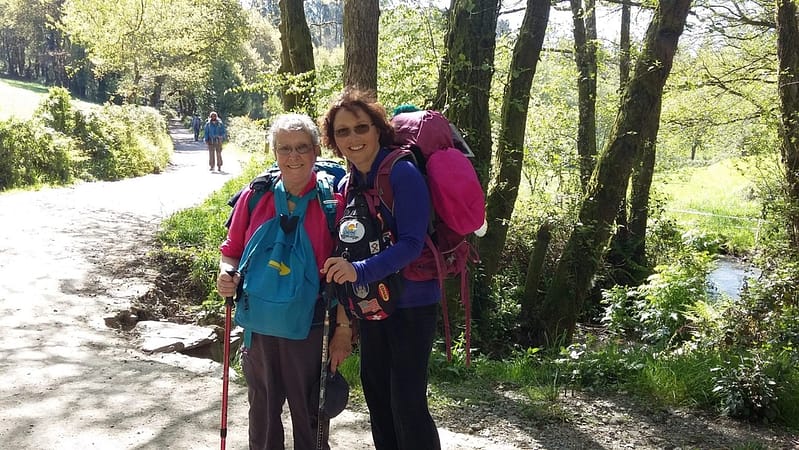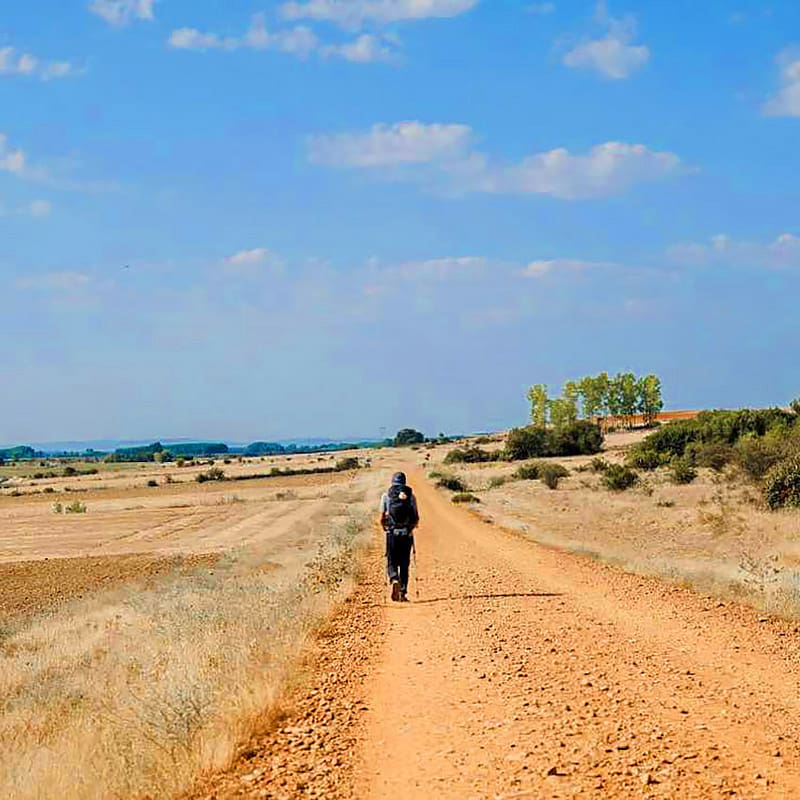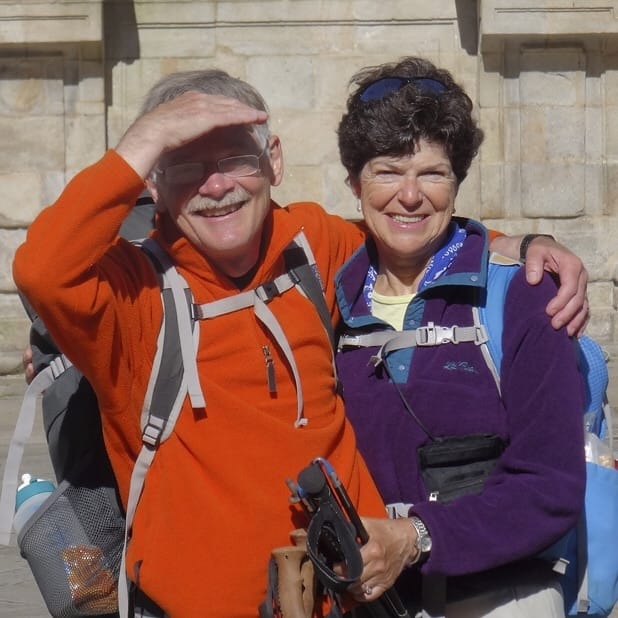“The Camino de Santiago de Compostela, or the Way of St. James, is an ancient pilgrimage route in the Galician mountains of northern Spain. It is many things to different people. Physically, emotionally and spiritually it is an amazing adventure that tests endurance and faith.
Beginning in the French Pyrenees, the route stretches across the mountains to the city of Santiago de Compostela in northwest Spain. The total journey can take between 5-7 weeks. My daughter, Sharon, and I chose to do the last 100 kms of the route and originally estimated it would take 13 days. However we completed it in 9 days at an average of 10 miles a day.
Our Camino had taken two years of on and off planning. Initially meant as a celebration of my eightieth birthday, family bereavements meant we waited for two years. This gave us, and me in particular, time to research and choose equipment carefully. Having type 2 diabetes, taking care of my feet was a priority. It took time to find suitable walking shoes and after buying a pair, I wore them almost continuously for three months, even in the house, until the shoes and I were well adjusted to each other! To avoid blisters while hiking, I used the ‘Vaseline and two pairs of socks method.’ First I would smother my feet well with a thick layer of Vaseline. I then wore a pair of thin hiking socks liners then traditional merino wool hiking socks. This worked well and I had no blisters the entire trip!
There is a well-developed system of hostels, or albergues, catering for the thousands of pilgrims. We walked from Sarria to Santiago and in this stretch albergues were about ten miles apart. They vary in size but commonly are large rooms equipped with bunks. Washing facilities may be very basic and most have showers. We stayed in one small albergue accommodating just eight people. Another had fifty bunks but only one toilet and communal showers. On some days, tired after a long day walking and not managing to find an albergue nearby my daughter and I stayed in a pension – a slightly more upscale lodging – with our own room and toilet!
To my surprise the average pilgrim was between fifty to seventy years old. Many we met were at a reflective time in life dealing with personal issues. There were people grieving after a death. One man whose wife had recently died carried a red candle which he would light at each overnight stop. Some pilgrims were dealing with serious illness but did not want that to define them.
There was something surreal about walking the ancient route. Removed from the familiarity of everyday life, people sometimes walked alongside others telling their stories and explaining their very personal reasons for doing the pilgrimage. We heard stories of heartache, loneliness illness and loss.
There were also several other memorable pilgrims we met. A group of seventeen year-old college students from Ireland were fun to meet. Their neat, tidy looks were soon changed as they had to walk through mud that reached their knees. But they did not moan, not even the girls who had started out with pretty pink trainers that soon got trashed in the mud. An Australian lady doing a gap year in Europe had heard about the Camino, thought it was a good idea, bought a pair of boots, and the next day started walking! Without sensible preparation it only took four days for her to have palm-sized infected blisters that needed daily antibiotic injections. We only met two English people, others were from Germany, Ireland, Australia, Italy, Sweden, Denmark and Bolivia.
For us, the journey started long before we left home and despite the preparation, at times on the trip I was anxious. I am not heroic or athletic and knew that I was taking on something bigger than myself. Just how big that would turn out to be only became obvious when I saw the first steep hill and deep trench of mud. Wanting to keep the backpack weight down my daughter and I had weighed everything on the kitchen scales – even our sox – choosing the options that weighed less. We were so grateful to have been careful about the weight we would carry. Aiming for four kilos, the actual weight including water was nearer to six kilos. For three days, the temperature reached nearly 80 degrees but we still had to walk carrying our backpacks. I sometimes poured water over my head to try and cool down. We also used small front-pacs. It was a convenient way to carry things used all the time, like like water, paracetamol, tissues, camera, and phone.
The physical challenge is real. Guidebooks explained the terrain was ‘hilly’ – it depends on what is meant by hilly! Walking in the mountains meant continually walking steeply uphill. We even walked up the side of a narrow waterfall. Thick black churned up mud often took some negotiating. On our first day, trying to hold onto a tree while finding firm footing, I slipped full length in the mud. I broke the straps on my front-pac and redesigned the look of my clothes. The mud soon dried, we bought a new pac and the bruise on my hip is slowly fading, long after I completed the trip. We heard tales of twisted knees, sprained ankles and infected blisters. Yet people dusted themselves down, bandaged themselves up and just continued.
I could never have done the Camino without the help of my amazing daughter. I am very independent and don’t like being helped. However I soon learned that to accept a helping hand when the trail was tricky was sensible. It was Sharon, who can speak Spanish, who did the hostel finding, ordered our meals, and taught me how to order coffee in the evening cafes. The Camino showed me that I am capable of stretching myself way beyond my own limits. This is a lesson to take into other areas of life.
Would I do this same route again? I would love to, but won’t. It’s an experience that can’t be replicated. However, there is a gentler route starting in Portugal. I would like to meet people who have started their pilgrimage there. It could be a possibility and I have started mentioning the idea to friends.
There were moments that had us helplessly laughing. My daughter was very proud to be taking her ‘old’ mother on the Camino. I would hear her saying to other pilgrims or to Spanish people ‘Madre mia…’ and knew that she was about to say, again, ‘My mother is eighty-two!’ Sturdy men, usually American, wanted to have their photograph taken with us. One man, telling his friends he wanted to go home, that it was all too hard, was persuaded to continue when he heard about ‘that lady who is eighty-two!’ Once, when we arrived at one coffee stop, two Italian ladies came rushing to meet us. They smothered me with hugs and kisses, saying ‘We heard you were coming, congratulations, you are very welcome!’ Well, Sharon and I laughed so much. I felt like an ancient monument.
The journey’s final steps are taken when walking into the ancient Cathedral of Santiago de Compostella. For me this was the culmination of an awesome pilgrimage. It was a sacred time of worship and of sharing in the Pilgrims Mass alongside people who had pushed themselves beyond fear, anxiety, blisters, wounds, and even serious illness and heartache. Nobody is free from pain on the Camino. In the Christian tradition, a special part of the usual Sunday morning church service is a moment when people greet each other. Usually they will say ‘God bless you’ or ‘The peace of Christ’. In the amazing Santiago cathedral as the priest announced the moment to share the Peace of Christ, it gave a whole new depth of meaning to the privilege of sharing the meaning of Christ. Pilgrims who were tired, elated and humbled hugged each other and even wept together at the awesome privilege of traveling a unique journey alongside very special people, yet ordinary people, who were true travel companions
Each pilgrim carried a large scallop shell on the back of the rucksack; it represents the changed life experienced on The Way and the realization that each pilgrim would return home a different person. I came home fitter, slimmer, somehow different and realizing that it has been possible to stretch myself beyond anything I thought possible. We did it!”
– Angela, England




